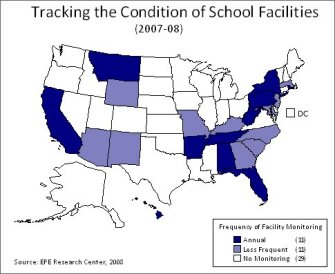Ensuring that students in our nation’s schools have access to enriching, safe, and healthy school environments constitutes a fundamental tenet of a quality public education. Such factors as teacher experience and qualifications or curricular standards are among the key elements of a school’s educational climate. But the physical conditions of school buildings and facilities also play a role in shaping a child’s educational experience.
For Quality Counts 2008, the EPE Research Center examined whether states routinely collect statewide information on the condition of school facilities using surveys or an alternative mechanism. Twenty-two states have such policies in place, with half of those states monitoring schools on an annual basis. Among states that do have formal statewide mechanisms in place, school conditions may be monitored using inspections, surveys, reports, or electronic databases. Although such policies deal primarily with the physical condition of facilities, the well-informed allocation of construction and renovation dollars can represent an important first step in providing a high-quality school environment that will support student learning.
For more state-by-state data on school conditions and other topics, search the EPE Research Center’s Education Counts database.



